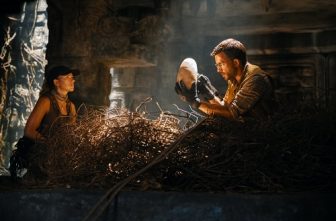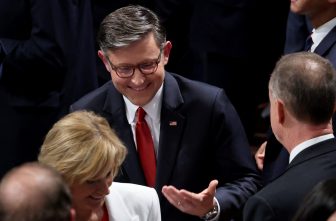To say that the Amazon Synod has caused a stir in the Church is an understatement. Twitter, the Catholic and secular media, and people in the parishes are talking about it. As I was teaching my canon law students about the Synod of Bishops, many questions and concerns were raised by them regarding what they had heard and read about the special session of the Synod of Bishops that was taking place concurrently with my class.
My view of the Amazon Synod is that of an outsider looking into it through the lens of Canon Law. My experience of the Amazon Basin is limited to a movie (“The Mission”), a TV show (“River Monsters”) and a trip — two of which are helpful to me now.
As a seminarian, my class traveled down to the archdiocesan mission in Ciudad Guayana, Venezuela, a large industrial city that rests in the confluence of the Orinoco and Caroni rivers. While there, we had the opportunity to go on a mini sightseeing trip to Brazil. On our two-day excursion, we drove 10 hours south toward the equator before ending in a jungle town in northern Brazil. In this quiet village, two things were very different: The people spoke Portuguese and the streams began to flow south. We were in the Amazon Rain Forest. Had we continued on that road from that secluded outpost, 70 hours and 3,100 miles later, we would have emerged from Amazon Basin and arrived soon after in Sao Paolo, Brazil. The small hamlet we visited was as a drop of water to the vastness of the ocean.
Within the Amazon Basin, there are roughly 33.6 million people living in nine different countries: Bolivia, Peru, Ecuador, Colombia, Venezuela, Brazil, Guyana, Suriname and French Guiana. As it was when the Jesuit missionaries embarked into the jungle in the 18th century, it still remains largely mission territory for the Church. Yet, missionary activity in the 21st century is vastly different from the missionary activity of the past captured in the powerful film “The Mission.” Missionaries have always faced geopolitical issues, but in the Amazon Basin of the 21st century they are unique: mass deforestation, ecological issues, migration, drugs, crime and conflict with indigenous people. Missionaries have always faced ecclesiastical difficulties as well, but in the Amazon Basin of the 21st century, they are unique: influence of pagan religions, loss of Catholics to Protestant ecclesial communities, lack of ordained ministers and the sacraments, and the close and often problematic relationship between missionary activity and colonialism.
Answering the question “How to better proclaim the Gospel in the Amazon?” was the sole purpose of the Amazon Synod that took place Oct. 6-27 in Rome. This fundamental question becomes more pressing when we consider that nearly three centuries of missionary activity have not produced the same fruit in the Amazon Basin as they have elsewhere in the world. In seeking to address this question, the synod fathers proposed a few controversial changes to Church discipline, but they also talked about addressing the issues surrounding mass migration, pressing ecological needs, proselytizing by Protestants, building a Catholic university, enculturation in the liturgy and creating a bishop’s conference for the Amazon. Some of the solutions were radical; most were rather mundane.
The robust dialogue that took place during the synod produced a summary document “Documento Final: Assemblea Especial Para La Región Panamazónica,” assembled by the synod fathers. The full text is posted on the Vatican website under the “Synod of Bishops” and is a presentation of the points discussed in the individual working groups. It is well worth reading. Though radical ideas were proposed during the course of the synod, the document itself is a lot less controversial. This is because the structure of the synod itself forces a broad consensus. For example, controversial calls for women deacons became a proposal for a deeper appreciation and respect for the roles of women in the Church. The idea of women deacons was acknowledged in the final document as having been discussed.
Now this document is in the hands of Pope Francis, who will write a post-synodal apostolic exhortation. He will take the fruits of the discussion and create a teaching document for the Church in the Amazon. As a teaching document, its purpose will not be to change Church discipline, but rather the pope will distill the wisdom of the synod fathers, born from successes and failures, and call the Church forward into a renewed effort to bring the Gospel to the Amazon Basin in a more effective manner.
We catch a glimpse of what his exhortation to the Church will be in the pope’s homily at the opening of the synod: “Dear brothers and sisters, together let us look to the crucified Jesus, to his heart pierced for our salvation. Let us begin there, the source of the gift that has given us birth. From that heart, the Spirit who renews has been poured forth (cf. Jn 19:30). Let each and every one of us, then, feel called to give life. So many of our brothers and sisters in Amazonia are bearing heavy crosses and awaiting the liberating consolation of the Gospel, the Church’s caress of love. So many of our brothers and sisters in Amazonia have given their lives. I would like to repeat here the words of our beloved Cardinal Hummes: When he arrives in those little towns of Amazonia, he goes to the cemetery to visit the tombs of missionaries. It is a gesture on the Church’s behalf for those who gave their lives in Amazonia. And then, with a little shrewdness, he says to the pope: ‘May they not be forgotten. They deserved to be canonized.’ For them and for all those who have given their lives and those who are still giving their lives, and with them, let us journey together.”
Instead of allowing the rancor surrounding the synod — the messiness of humanity — to discourage us, let us be encouraged by the witness of the missionaries and martyrs to whom Pope Francis directs our attention. Their mission is far from complete in the most remote corner of the world. The fruit of the synod will not be the words that were said in Rome last month, the hand-wringing that they caused, or changes to Church discipline, but the proclamation of the Gospel in the arched nave of a cathedral painted green with leaves deep in the Amazon.
Father Johnson is the judicial vicar of the Archdiocese of St. Paul and Minneapolis.




